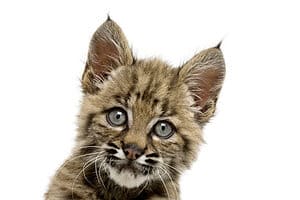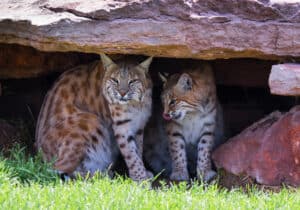California hosts many species throughout its vast territory, many of which are found throughout North America. The bobcat is present throughout the state, and with expanding urbanization, it becomes more likely that humans will come across these fascinating felines. Naturally, one wonders how dangerous such encounters would be and how to respond in such a situation.
About Bobcats

There are an estimated 70,000 to 100,000 bobcats in California.
©Laurie E Wilson/Shutterstock.com
Bobcats are small members of the Lynx genus and are very efficient hunters. They weigh about 15-25 pounds and are approximately two to three times the size of the average house cat. Their “bobbed” tails are about 4-6 inches long and are much shorter than those of the mountain lion or house cat. They have tufts of fur on the tips of their ears and visible spots on their coats. They also have hair on the sides of their faces, which resemble sideburns, though those on their cousin, the lynx, are much more pronounced.
Where Do Bobcats Live in California?
Bobcats are found throughout North America, as well as throughout the state of California. They prefer brushy and rocky terrain, mainly near rivers. They like dense overgrowth, stone ledges, and crevices to provide shelter and camouflage. Though they prefer these areas, human development has encroached upon their habitat, and they are adjusting to the urban edges of their environment. They are very adaptable, though urban threats such as traffic can be dangerous.
How Many Bobcats are in California?
The California Department of Fish and Wildlife is developing a conservation and management plan for the California bobcat. This plan will include an updated count and an overview of population health and trends. At last count, bobcats in California numbered somewhere between 70,000 and 100,000.
What Do Bobcats Eat?
Bobcats are primarily carnivorous and are a healthy part of the Californian ecosystem, controlling populations of smaller wildlife throughout the state. They will hunt and eat animals ranging in size from insects to deer fawns; this includes birds, frogs, snakes, salamanders, toads, raccoons, porcupines, rabbits, and rodents, including squirrels and wood rats.
Unfortunately, their predation will extend to livestock and pets if left unsecured at night. Family cats, dogs, rabbits, and rodents are particularly vulnerable. Livestock like ducks, chickens, piglets, and lambs can also fall prey to this opportunistic feeder.
Bobcats have also been seen to eat grass and other vegetation, though that is not a significant component of their dietary consumption.
Are Bobcats Dangerous?
While bobcats are efficient hunters and predatory of small pets and livestock, they are naturally shy and solitary, usually looking to avoid human contact. Recorded attacks on humans are rare. If you run across a bobcat, it’s best to stop and slowly walk backward to avoid triggering its pursuit instinct. Given a chance, the bobcat will typically go the other way, avoiding what they see as an unwanted confrontation.
The photo featured at the top of this post is © Don Mammoser/Shutterstock.com
Thank you for reading! Have some feedback for us? Contact the AZ Animals editorial team.






